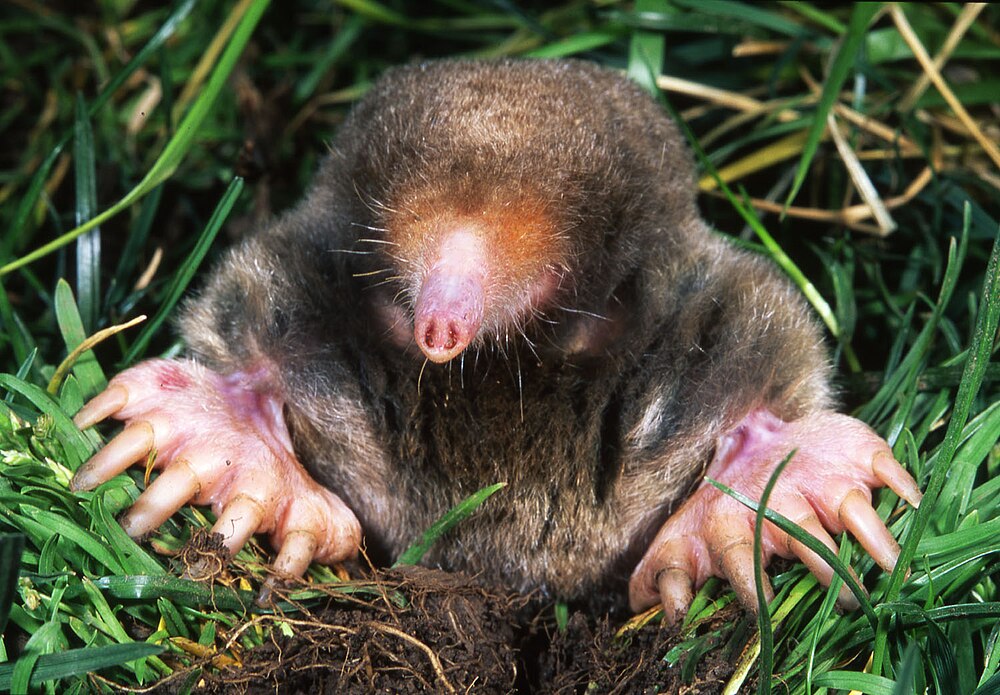How many baby Eastern moles are in a litter?
A Eastern mole (Scalopus aquaticus) usually gives birth to around 3 babies.With 1 litters per year, that sums up to a yearly offspring of 3 babies.
Each of those little ones spend around 42 days as a fetus before they are released into the wild. Upon birth, they weight 5 grams (0.01 lbs) and measure 1.6 cm (0′ 1″). They are a member of the Talpidae family (genus: Scalopus). An adult Eastern mole grows up to a size of 12.5 cm (0′ 5″).
To have a reference: Humans obviously usually have a litter size of one ;). Their babies are in the womb of their mother for 280 days (40 weeks) and reach an average size of 1.65m (5′ 5″). They weight in at 62 kg (137 lbs), which is obviously highly individual, and reach an average age of 75 years.

The eastern mole or common mole (Scalopus aquaticus) is a medium-sized, overall grey North American mole and the only member of the genus Scalopus. Its large, hairless, spade-shaped forefeet are adapted for digging. The species is native to Canada (Ontario), Mexico, and the eastern United States, and has the widest range of any North American mole.The species prefers the loamy soils found in thin woods, fields, pastures, and meadows, and builds both deep and shallow burrows characterized by discarded excess soil collected in molehills. Its nest is composed of leaves and grasses, and its two to five young are on their own at about four weeks. Its diet consists principally of earthworms and other soil life, but the eastern mole will also eat vegetable matter.Dogs, cats, foxes, and coyotes prey upon the eastern mole, and the species hosts a variety of parasites. Unlike gophers, moles do not eat vegetation and pose no threat to human concerns; the occasional damage to lawns is offset by the aeration provided the soil and consumption of insects. The construction of golf courses has provided the mole with ideal habitat. The species is abundant, occurs in protected areas, faces no major threats and is of little concern to conservationists.
Other animals of the family Talpidae
Eastern mole is a member of the Talpidae, as are these animals:
- Hairy-tailed mole with 4 babies per pregnancy
- Kloss’s mole with 4 babies per pregnancy
- Japanese mountain mole with 3 babies per pregnancy
- Kobe mole with 3 babies per pregnancy
- True’s shrew mole with 2 babies per pregnancy
- American shrew mole with 2 babies per pregnancy
- Inquisitive shrew mole raching a size of 7.5 cm (0′ 3″)
- Blind mole weighting only 70 grams
- Townsend’s mole with 1 babies per pregnancy
- Himalayan mole becoming 1.5 years old
Animals that share a litter size with Eastern mole
Those animals also give birth to 3 babies at once:
- Southern mole vole
- Western red-backed vole
- Western red-backed vole
- Mountain pygmy possum
- Amazonian marsh rat
- Baluchistan pygmy jerboa
- Borneo black-banded squirrel
- Short-tailed mongoose
- Oligoryzomys fulvescens
- Long-nosed dasyure
Animals that get as old as a Eastern mole
Other animals that usually reach the age of 6.17 years:
- Rakali with 6.17 years
- Brush-tailed phascogale with 5 years
- Tailless tenrec with 6.25 years
- Serotine bat with 6 years
- San Joaquin antelope squirrel with 5.5 years
- North African hedgehog with 7 years
- Mountain degu with 7.33 years
- Northern grasshopper mouse with 5 years
- Eastern quoll with 6.75 years
- Brown-eared woolly opossum with 5 years
Animals with the same weight as a Eastern mole
What other animals weight around 87 grams (0.19 lbs)?
- Big deer mouse weighting 71 grams
- Heath mouse weighting 72 grams
- Cape gerbil weighting 92 grams
- Highveld gerbil weighting 89 grams
- Dressy Oldfield mouse weighting 76 grams
- Dark-tailed tree rat weighting 71 grams
- Biak glider weighting 90 grams
- Angoni vlei rat weighting 100 grams
- Amazon dwarf squirrel weighting 92 grams
- Southern climbing mouse weighting 89 grams
Animals with the same size as a Eastern mole
Also reaching around 12.5 cm (0′ 5″) in size do these animals:
- Mount Apo forest mouse gets as big as 10.9 cm (0′ 5″)
- Long-nosed dasyure gets as big as 12.1 cm (0′ 5″)
- Mexican deer mouse gets as big as 12.4 cm (0′ 5″)
- Merriam’s chipmunk gets as big as 13.4 cm (0′ 6″)
- Patagonian opossum gets as big as 13.6 cm (0′ 6″)
- Shaw Mayer’s brush mouse gets as big as 14.4 cm (0′ 6″)
- Paraguayan fat-tailed mouse opossum gets as big as 12.7 cm (0′ 5″)
- Arends’s golden mole gets as big as 12.3 cm (0′ 5″)
- Grassland mosaic-tailed rat gets as big as 10.8 cm (0′ 5″)
- California vole gets as big as 13.9 cm (0′ 6″)
